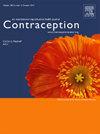计划生育学会临床推荐:癌症患者和癌症幸存者的避孕注意事项,第2部分-乳腺癌、卵巢癌、子宫癌和宫颈癌。
IF 2.3
2区 医学
Q1 OBSTETRICS & GYNECOLOGY
引用次数: 0
摘要
本临床建议提供循证、以人为本和以公平为导向的建议,以促进对诊断为乳腺癌、卵巢癌、子宫癌或宫颈癌、正在积极治疗或曾经接受过治疗的个体的管理和获得避孕护理。对于有乳腺癌病史的个体,我们建议将非激素避孕药作为一线选择(1B级);根据乳腺癌激素受体的状态,对激素避孕提供了额外的指导。对于有卵巢癌病史或活动性的个体,我们建议临床医生采用以人为本的方法提供所有可用的避孕方法(1B级);对于被诊断为激素敏感性卵巢恶性肿瘤的个体,如成人颗粒细胞瘤、低级别浆液性和子宫内膜样腺癌,如果考虑使用激素避孕,我们建议与患者及其肿瘤科医生共同决策(2C级)。接受雌激素阻断治疗的个体应避免使用含雌激素的避孕药(最佳做法)。对于有子宫内膜癌病史的个体,我们建议临床医生采用以人为本的方法提供所有可用的避孕方法(1B级);对于需要宫内节育器(IUD)的活动性子宫内膜癌患者,我们建议与患者及其肿瘤科医生共同决策(1B级)。对妊娠滋养细胞疾病患者的建议是基于诸如持续的宫内疾病证据、人绒毛膜促性腺激素(hCG)水平和个人首选的避孕方法等因素提供的。对于宫颈发育不良或有宫颈癌病史的个体,我们建议临床医生提供所有可用的避孕方法(2B级);我们建议活动期宫颈恶性肿瘤患者(2C级)不宜放置宫内节育器。本文档是计划生育学会2012年癌症和避孕临床指南更新系列三部分的第二部分。它以计划生育协会委员会声明中概述的考虑因素为基础:癌症患者和癌症幸存者的避孕考虑因素第1部分-临床护理的关键考虑因素,并与计划生育协会临床建议:癌症患者和癌症幸存者的避孕考虑因素第3部分-皮肤,血液,胃肠道,肝脏,肺部,中枢神经系统和其他癌症。我们鼓励读者复习第1部分和第3部分,以获得这个额外的上下文。本文章由计算机程序翻译,如有差异,请以英文原文为准。
Society of Family Planning Clinical Recommendation: Contraceptive considerations for individuals with cancer and cancer survivors part 2 – Breast, ovarian, uterine, and cervical cancer: Joint with the Society of Gynecologic Oncology
This Clinical Recommendation provides evidence-informed, person-centered, and equity-driven recommendations to facilitate the management of and access to contraceptive care for individuals who are diagnosed with, being actively treated for, or who have previously been treated for breast, ovarian, uterine, or cervical cancer. For individuals with a history of breast cancer, we recommend nonhormonal contraceptives as the first-line option (GRADE 1B); additional guidance is provided for hormonal contraception depending on breast cancer hormone receptor status. For individuals with a history of or active ovarian cancer, we recommend clinicians provide access to all available contraceptive methods utilizing a person-centered approach (GRADE 1B); in individuals diagnosed with hormonally-sensitive ovarian malignancies, such as adult granulosa cell tumors, low-grade serous, and endometrioid adenocarcinomas, who are considering hormonal contraception, we suggest shared decision-making with the individual and their oncologist (GRADE 2C). Estrogen-containing contraceptives should be avoided by individuals treated with estrogen-blocking therapy (Best Practice). For individuals with a history of endometrial cancer, we recommend clinicians provide access to all available contraceptive methods utilizing a person-centered approach (GRADE 1B); in individuals with active endometrial cancer requesting an intrauterine device (IUD), we suggest shared decision-making with the individual and their oncologist (GRADE 1B). Recommendations for individuals with gestational trophoblastic disease are provided based on factors such as evidence of persistent intrauterine disease, human chorionic gonadotropin (hCG) levels, and the individual’s preferred contraceptive method. For individuals with cervical dysplasia or a history of cervical cancer, we suggest clinicians provide access to all available contraceptive methods (GRADE 2B); we suggest against IUD placement in individuals with active cervical malignancy (GRADE 2C). This document is part 2 of a three-part series that updates the Society of Family Planning’s 2012 Cancer and contraception clinical guidance. It builds upon the considerations outlined in the Society of Family Planning Committee Statement: Contraceptive considerations for individuals with cancer and cancer survivors part 1 – Key considerations for clinical care and parallels recommendations outlined in the Society of Family Planning Clinical Recommendation: Contraceptive considerations for individuals with cancer and cancer survivors part 3 – Skin, blood, gastrointestinal, liver, lung, central nervous system, and other cancers. Readers are encouraged to review parts 1 and 3 for this additional context.
求助全文
通过发布文献求助,成功后即可免费获取论文全文。
去求助
来源期刊

Contraception
医学-妇产科学
CiteScore
4.70
自引率
17.20%
发文量
211
审稿时长
69 days
期刊介绍:
Contraception has an open access mirror journal Contraception: X, sharing the same aims and scope, editorial team, submission system and rigorous peer review.
The journal Contraception wishes to advance reproductive health through the rapid publication of the best and most interesting new scholarship regarding contraception and related fields such as abortion. The journal welcomes manuscripts from investigators working in the laboratory, clinical and social sciences, as well as public health and health professions education.
 求助内容:
求助内容: 应助结果提醒方式:
应助结果提醒方式:


